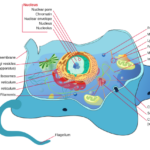Cell Parts & Functions
Every cell comprises important parts, each with a unique role that helps the cell function and stay alive.
- Cell Membrane: The outer layer that protects the cell and controls what enters and exits.
- Nucleus: The “control center” of the cell that contains DNA and directs all activities.
- Cytoplasm: The jelly-like substance that fills the cell, where all the organelles are found.
- Mitochondria: Known as the “powerhouse” of the cell, they generate energy by breaking down nutrients.
- Endoplasmic Reticulum (ER): Acts like a highway to transport materials within the cell.
Organelles: The Cell’s Tiny Machines
These tiny machines, called organelles, work together inside the cell to process materials, generate energy, and keep everything running smoothly.
- Ribosomes: Small structures that make proteins, the building blocks of life.
- Golgi Apparatus: Like a post office, it packages and ships proteins and other materials.
- Lysosomes: The cell’s “recycling center” breaks down waste and old cell parts.
- Vacuoles: Storage compartments that store nutrients, water, and waste products.
- Chloroplasts (only in plant cells): Contain chlorophyll and perform photosynthesis, helping plants make food.
How do Cells Communicate?
Cells constantly communicate with each other through signals and connections, allowing them to work together and keep the body functioning smoothly.
Cell Signaling: Cells send and receive signals using chemical messengers like hormones to communicate with each other.
Receptors: Special proteins on the surface of cells receive signals and pass the message inside the cell, telling it what to do.
Gap Junctions: In animal cells, tiny channels directly connect neighboring cells, allowing them to share essential molecules.
When cells work together, they can help heal wounds, grow new tissue, or protect the body from infections.
Fun Facts
Here are some interesting facts about cells:
- Our body is made up of about 37 trillion cells!
- The longest cell in our body is the motor neuron—it can be up to 3 feet long!
- Red blood cells are so small that 5 million can fit on a pin’s head.
- Plant cells have a cell wall, which gives them a rigid structure, unlike animal cells.
- Brain cells (neurons) can send signals to each other at speeds of up to 250 miles per hour!
Review
Let’s quickly recap what we learned about the anatomy of a cell:
- What is the control center of the cell? Nucleus
- What part of the cell generates energy? Mitochondria
- What jelly-like substance fills the cell? Cytoplasm
- Which organelle is the recycling center of the cell? Lysosomes


Recent Comments